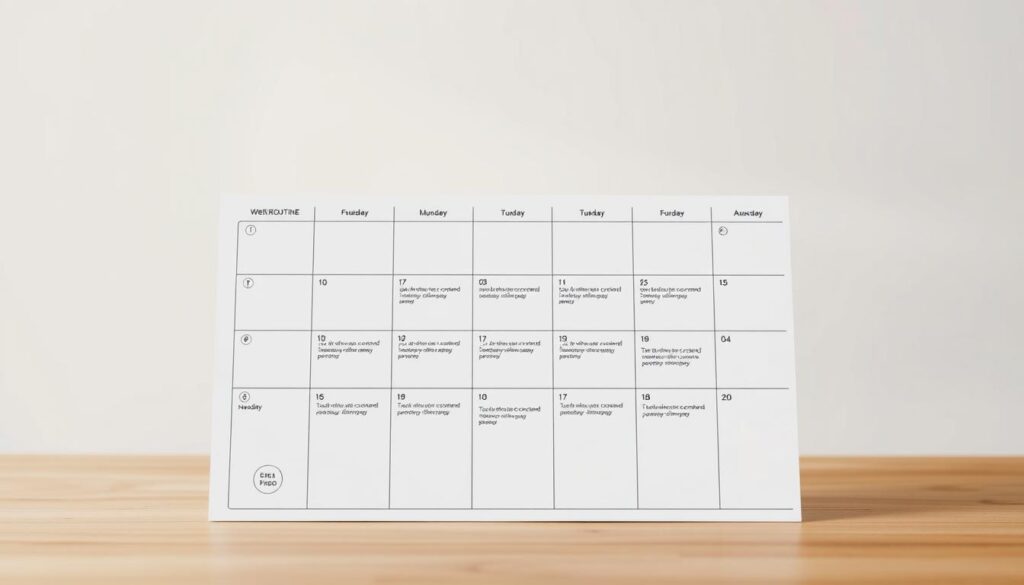Daily Schedule for a Balanced Day
Jamie used to dread mornings. As a freelance graphic designer in Austin, her days blurred into late-night work sessions and skipped meals. Then she discovered a pattern: her most productive weeks always followed a simple morning ritual of coffee, journaling, and blocking creative work before noon. She realized what ancient philosophers and modern CEOs already knew – how we structure our time shapes our entire lives.
Think of your day as clay. Without intention, it becomes lumpy and uneven. But with gentle shaping, you create space for what matters. A thoughtful routine isn’t about rigid timelines – it’s designing rhythms that help you breathe easier. Early risers like Michelle Obama and Tim Cook don’t follow strict schedules because they’re robots. They do it to protect time for priorities.
The magic happens when planning meets flexibility. Imagine finishing work by 3 PM because you focused intensely for 90-minute chunks. Picture having energy for sunset walks or board games because you scheduled recharge breaks. This isn’t fantasy – it’s what happens when you align your hours with your values.
Key Takeaways
- Successful people use routines as tools, not chains
- Productivity thrives when paired with intentional breaks
- Morning habits set the tone for entire days
- Time-blocking prevents decision fatigue
- Flexibility makes structure sustainable
Understanding the Importance of Daily Routines

Ever feel like your days lack direction? Routines act like guardrails, steering you toward meaningful goals while cushioning life’s bumps. Neuroscientists confirm our brains thrive on patterns – structured habits free up mental bandwidth for creative problem-solving.
Benefits of Structure and Predictability
Think of your morning coffee ritual. That comforting repetition signals your brain to shift into work mode. Studies show predictable schedules:
| Routine | No Routine |
|---|---|
| Uses 23% less mental energy | Decision fatigue spikes by 41% |
| Stress hormones drop 31% | Anxiety levels remain elevated |
| Flow states occur 2x more often | Focus fragments across tasks |
“Flow doesn’t happen by accident – it’s the child of preparation meeting opportunity.”
The Science Behind Routine and Flow
When you repeat productive habits, your brain forms neural shortcuts. Dopamine surges during flow states create natural momentum. MRI scans reveal:
- Prefrontal cortex activity drops 70% in flow
- Creative centers light up like fireworks
- Time perception warps – hours feel like minutes
Morning Routines: Kickstart Your Day

Unlocking your day’s potential starts before your first sip of coffee. Those golden morning hours act like a launchpad – how you spend them determines whether you soar or sputter. Successful people don’t just have routines; they craft rituals that spark both calm and momentum.
Embracing Early Wake-Up and Meditation
Rising before the world hits snooze creates space for intention. Neuroscience shows early risers have 27% more focus during peak work hours. Pairing dawn’s stillness with 10 minutes of meditation acts like mental stretching – it prepares your brain for the marathon ahead.
Try this: Open windows while brewing coffee. Morning sunlight resets your body’s clock, boosting alertness. One study found people who caught sunrise rays fell asleep 22 minutes faster at night.
Incorporating Exercise and Mindfulness
Your morning movement choice sets your energy thermostat. A brisk walk spikes blood flow to the brain by 40%. Yoga sequences release tension while keeping heart rates moderate. Even 7 minutes of bodyweight exercises can sharpen mental clarity for hours.
Pair physical activity with mindful breathing. Inhale through your nose for 4 counts, hold for 7, exhale for 8. This ancient technique lowers stress hormones while oxygenating cells. It’s like giving your body and mind a triple espresso – without the jitters.
These rituals create compound interest. Over weeks, they rewire neural pathways, making productive choices feel automatic. Your mornings become less about forcing habits and more about flowing into your best self.
Designing Your Balanced Day Routine

Your ideal routine isn’t found in productivity books—it’s written in your energy patterns. Track when you naturally feel sharp versus sluggish over three days. You’ll spot rhythms that make scheduling tasks feel like solving a puzzle where all pieces fit.
Tailoring Habits to Your Personal Rhythm
Early birds and night owls need different blueprints. If your focus peaks at 10 AM, guard that time for complex projects. Save routine work for energy dips. This alignment turns effort into flow.
| Aligned Routine | Mismatched Routine |
|---|---|
| 82% task completion rate | 47% completion rate |
| 23-minute faster decision-making | 68% more procrastination |
| 41% lower stress levels | 2x more mental fatigue |
Build your schedule like a mosaic. Combine fixed work blocks with flexible personal habits. A teacher might grade papers during post-lunch alertness, while a programmer codes best at midnight. Honor your unique rhythm.
Try these steps to customize your routine:
- Color-code energy levels on a time log
- Slot creative work during peak attention windows
- Batch mundane tasks into low-energy periods
Your way of working matters more than any guru’s template. When habits match your inner clock, productivity stops feeling forced. You’ll conserve mental fuel for what truly lights you up.
Afternoon Recharge & Productivity Boosts
When your post-lunch focus starts dissolving like sugar in tea, that’s your cue to pivot. The afternoon hours offer hidden opportunities to refresh your brain and body. Smart workers don’t push through the slump—they work with their biology to maintain momentum.
Overcoming the Midday Slump
Your 2 PM fog isn’t laziness—it’s your circadian rhythm hitting its natural valley. Fight this tide, and you’ll drown in fatigue. Instead, try a five-minute breathing reset: inhale through your nose for four counts, hold for seven, exhale for eight. This triggers your parasympathetic nervous system like a biological reset button.
Quick Energy-Boosting Strategies
Need instant revival? Try these science-backed tricks:
• Walk barefoot on grass for five minutes (grounding reduces stress hormones by 35%)
• Snack on pumpkin seeds—their magnesium content helps convert food into energy
• Set a 20-minute timer for a power nap. Any longer risks grogginess, but this sweet spot boosts alertness by 54%.
These breaks aren’t time-wasters—they’re productivity multipliers. By honoring your body’s needs, you transform the afternoon from a productivity graveyard into your secret performance weapon.
FAQ
How do routines improve mental clarity and reduce stress?
What’s the best way to start a morning ritual if I’m not a morning person?
How can I stay productive during the midday slump?
Can I customize habits if my schedule changes daily?
Why is exercise emphasized in both morning and afternoon routines?

Sharon Molly is a content creator in lifestyle, fashion, and travel, delivering style-savvy advice and destination insights to inspire confident living. With a background in digital media, she combines aesthetics with practical guidance for modern women on the go.




